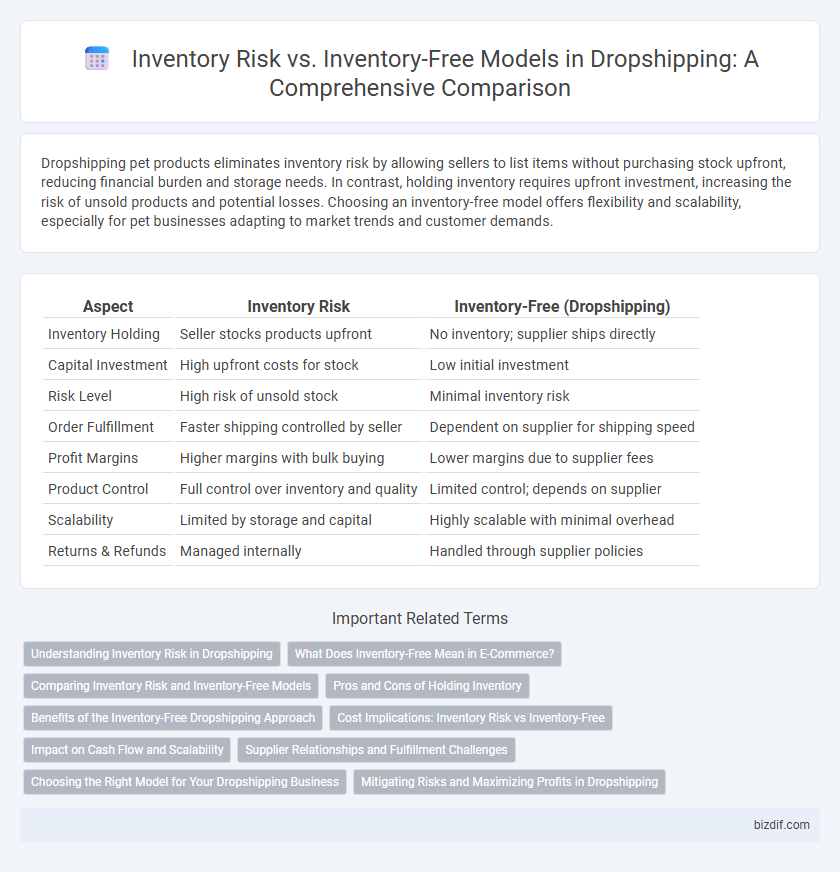Dropshipping pet products eliminates inventory risk by allowing sellers to list items without purchasing stock upfront, reducing financial burden and storage needs. In contrast, holding inventory requires upfront investment, increasing the risk of unsold products and potential losses. Choosing an inventory-free model offers flexibility and scalability, especially for pet businesses adapting to market trends and customer demands.
Table of Comparison
| Aspect | Inventory Risk | Inventory-Free (Dropshipping) |
|---|---|---|
| Inventory Holding | Seller stocks products upfront | No inventory; supplier ships directly |
| Capital Investment | High upfront costs for stock | Low initial investment |
| Risk Level | High risk of unsold stock | Minimal inventory risk |
| Order Fulfillment | Faster shipping controlled by seller | Dependent on supplier for shipping speed |
| Profit Margins | Higher margins with bulk buying | Lower margins due to supplier fees |
| Product Control | Full control over inventory and quality | Limited control; depends on supplier |
| Scalability | Limited by storage and capital | Highly scalable with minimal overhead |
| Returns & Refunds | Managed internally | Handled through supplier policies |
Understanding Inventory Risk in Dropshipping
Inventory risk in dropshipping arises when retailers hold stock, exposing them to potential losses from unsold products, obsolescence, or demand fluctuations. This risk contrasts with the inventory-free dropshipping model, where sellers list products without physical stock, transferring inventory management and associated financial burdens to suppliers. Understanding inventory risk helps dropshippers optimize cash flow, reduce overhead costs, and focus on marketing and customer service for scalable business growth.
What Does Inventory-Free Mean in E-Commerce?
Inventory-free in e-commerce refers to a business model where retailers sell products without holding physical stock, relying instead on suppliers or manufacturers to fulfill orders directly to customers. This approach minimizes inventory risk by eliminating upfront investment in inventory and reducing the potential for unsold stock. Inventory-free dropshipping optimizes cash flow and scalability, allowing businesses to offer a wide product range without the burden of inventory management.
Comparing Inventory Risk and Inventory-Free Models
Inventory risk models require businesses to purchase and hold stock upfront, increasing exposure to unsold products and capital tied in inventory, whereas inventory-free dropshipping eliminates this risk by fulfilling orders directly from suppliers without pre-purchasing goods. Inventory risk can lead to higher profit margins if demand forecasts are accurate but poses financial risks from unsold inventory, while inventory-free models reduce financial burden and storage costs but often result in thinner margins and reliance on third-party supplier reliability. Choosing between inventory risk and inventory-free strategies depends on capital availability, risk tolerance, and supply chain control preferences in the dropshipping business.
Pros and Cons of Holding Inventory
Holding inventory in dropshipping allows for faster order fulfillment and better control over product quality, which can enhance customer satisfaction and brand reliability. However, it involves significant financial risk due to upfront investment in stock, potential overstocking, and storage costs that can impact cash flow. Conversely, inventory-free models minimize financial risk and storage expenses but may lead to longer shipping times and less control over product availability and quality.
Benefits of the Inventory-Free Dropshipping Approach
Inventory-free dropshipping minimizes upfront costs by eliminating the need to purchase and store products, reducing financial risk and improving cash flow management. This approach enhances scalability and flexibility, allowing businesses to quickly adapt to market trends without the constraints of excess inventory. By leveraging supplier-managed stock, sellers can focus on marketing and customer experience, streamlining operations and accelerating growth.
Cost Implications: Inventory Risk vs Inventory-Free
Inventory risk in dropshipping involves upfront costs for purchasing, storing, and managing stock, increasing capital investment and potential losses from unsold products. Inventory-free models eliminate storage expenses and reduce financial risk by only purchasing items after a customer places an order, enabling lower initial costs and improved cash flow. However, inventory-free setups might face higher per-unit purchasing costs and potential delays impacting profit margins.
Impact on Cash Flow and Scalability
Inventory risk in dropshipping ties up cash in unsold stock, limiting cash flow and slowing scalability due to capital constraints. Inventory-free models free up working capital, enabling faster cash circulation and easier expansion without the burden of excess inventory. Efficient cash flow management in inventory-free setups supports rapid scaling and reduces financial risk compared to traditional inventory-holding methods.
Supplier Relationships and Fulfillment Challenges
Supplier relationships play a critical role in managing inventory risk, as dropshipping relies heavily on the supplier's ability to maintain stock and fulfill orders promptly. Inventory-free models reduce upfront costs but depend on transparent communication and reliable fulfillment processes to avoid delays and stockouts. Strong partnerships with suppliers enable better tracking, faster problem resolution, and improved customer satisfaction in dropshipping operations.
Choosing the Right Model for Your Dropshipping Business
Choosing the right model for your dropshipping business depends on understanding the trade-offs between inventory risk and inventory-free approaches. Inventory risk involves purchasing and holding products upfront, leading to higher control over stock and faster shipping but increased capital requirements and potential for unsold items. Inventory-free dropshipping minimizes upfront costs and storage needs by relying on suppliers to fulfill orders directly, improving cash flow and flexibility while requiring strong supplier reliability and communication.
Mitigating Risks and Maximizing Profits in Dropshipping
Inventory risk in dropshipping involves holding stock that may not sell, leading to potential losses, whereas an inventory-free model eliminates upfront inventory costs by directly shipping from suppliers to customers. Mitigating risks requires strong supplier relationships, real-time inventory tracking, and automated order management to avoid stockouts and overselling. Maximizing profits depends on optimizing product selection, pricing strategies, and leveraging data analytics to respond swiftly to market demand fluctuations.
Inventory Risk vs Inventory-Free Infographic

 bizdif.com
bizdif.com